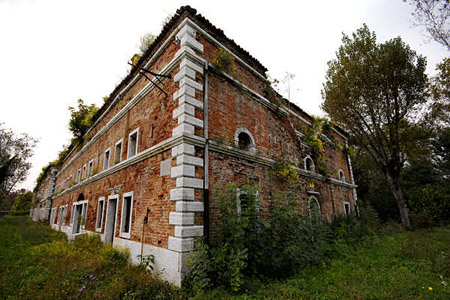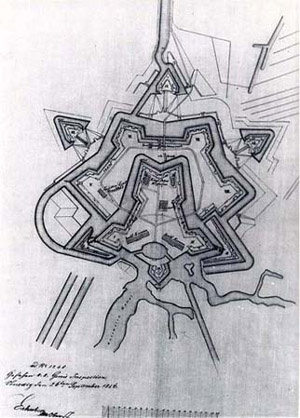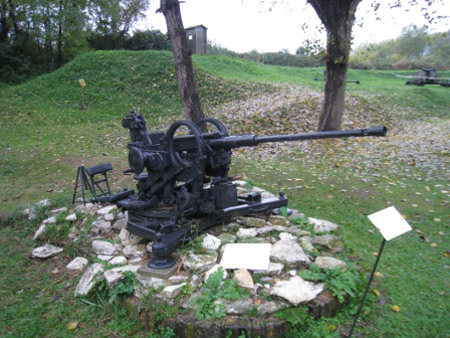 |
Forte Marghera
Venice, Italy
|
|
 |
On May 12 1797, Napoleon Bonaparte (1769-1821) conquered the ancient city/state of Venice. Venice had been perhaps the most glamorous and influential city in the world through the 18th century, a republic in and of itself that set trends in fashion, art and literature. Venice's Jews were pleased by this development, as Napoleon removed restrictions on where they could travel and live in the city, but one imagines they were the only ones who were gleefully pumping their fists in the air.
Six months later, the Treaty of Campo Formio shuffled some conquered lands betwixt France and Austria, and Venice became the property of the Austrian Monarchy...who immediately said, y'know what this city needs? A starfort! They couldn't have been more right, because every city needs a starfort. They chose to build their fort at the location of an old fishing village called Marghera. Bye, old fishing village.
|
The Treaty of Pressburg in 1805 made Venice part of Napoleon's Kingdom of Italy, since he decided that he'd rather be King than President. This of course meant that Venice belonged to France again! The Austrians were ejected and replaced by French folks, who noted that the Austrians had been building their fort wrong, and took over construction of Forte Marghera.
Nine years later? Back to Austria! Napoleon was finally (and temporarily) defeated when armies of the nations allied against him entered Paris on March 30 1814.
|
 |
 These lovely orange buildings were erected by the French. These lovely orange buildings were erected by the French. |
|
Venice was officially ceded back to Austria on April 26 1814. Austria bellowed FINALLY we will finish this fort, which the French were building incorrectly anyway.
The Venetian Republic was briefly reestablished in 1848, when the city's population rose against the Austrian occupiers. Whether the Austrian garrison of Fort Marghera resisted or not is unclear, but they surrendered the fort on March 22 1848.
|

|
 |
Joy! Rapture! The evil Austrian horde has been ejected from the sacred soil (water) of Venice! Men flocked from all around Italy to defend Forte Marghera, and by the time the not-quite-defeated Austrian army returned to Venice with some 24,000 men at the end of April 1848, the fort was defended by around 2400 Italian dudes.
The Austrians patiently surrounded the forte with an enormous array of guns, with which they pounded Marghera's defenders into submission after 22 days of bombardment. "Approximately 70,000 bullets between balls, bombs and grenades" were launched at the fort, according to the charming but difficult-to-translate Museum of Forte Marghera site.
Austria enjoyed its reconquered Venitian state until 1866, when the Austro-Prussian War put a big cimp in Austria's style, hastened the unification of Germany and somehow returned Venice to the French in the form of Napoleon III (1808-1873). This Napoleon may have been a twerp, but he at least had the wisdom to fork Venice directly over to the Kingdom of Italy. Which, most people would agree, seems like where it belongs.
|
|
|
The leadup to the First World War (1914-1918) saw a series of smaller, more modern fortifications sprout up in and around Venice: Forts with such names as Parmar, Sirtori, Makossa and Cosenz Rossaro, among others....if they're still around, I sure can't see 'em on Google Maps. These new defenses relegated Forte Marghera to a logistic role, and the fort was used for storage and a cool place for troops to hang out while waiting for stuff to happen. Venice's reported seventy individual fortifications kept the Austrians out of the city.
 Forte Marghera looks like it might make for a pleasant picnic spot, but at the moment it's looking kind of creepy. Forte Marghera looks like it might make for a pleasant picnic spot, but at the moment it's looking kind of creepy.
Because, let's face it, that tree in the center is creepy with a capital K.
Venice also mostly escaped damage during the Second World War (1939-1945), although the Marghera area was reportedly industrial, and did get a wee bit of attention from Britain's Royal Air Force. Allied policy was to avoid the destruction of historic architecture at all costs (unless that architecture was in Germany!), but towards the end of the war Germany was increasingly taking advantage of this by using Venice as a waypoint for a great deal of naval and munitions-shipping activity.
|
This led to the RAF's Operation Bowler, so named because any pilot who inadvertently damaged any of Venice that wasn't intended for destruction would find himself bowler hatted, or kicked out of the service and into civilian life (where that ex-pilot would presumably wear a bowler hat). This mission sent an RAF squadron over Venice on March 21 1945, where they carefully dive-bombed several German ships to the bottom of Venice's harbor. Local residents felt unthreatened enough to climb onto closeby rooftops to enjoy the spectacle.
In 1951 Forte Marghera was taken over by an Artillery Direction unit of
|
 |
 An adorable 38mm antiaircraft gun once utilized at Forte Marghera An adorable 38mm antiaircraft gun once utilized at Forte Marghera |
|
the Italian army, and in 1984 an army supply unit was stationed there.
Today, Forte Marghera looks to be a pleasant spot for either a relaxing repose amongst its myriad lightly crumbling buildings, moats and canals, or an exciting, slightly dangerous (did I mention that the buildings are crumbly?) romp through the multinational history of this strange but lovely fortification. Thanks to Italian starfort fan Piero, whose recent email inspired me to sniff out a fresh Italian starfort for the gallery!
|
|
|
|
|
|
 |




